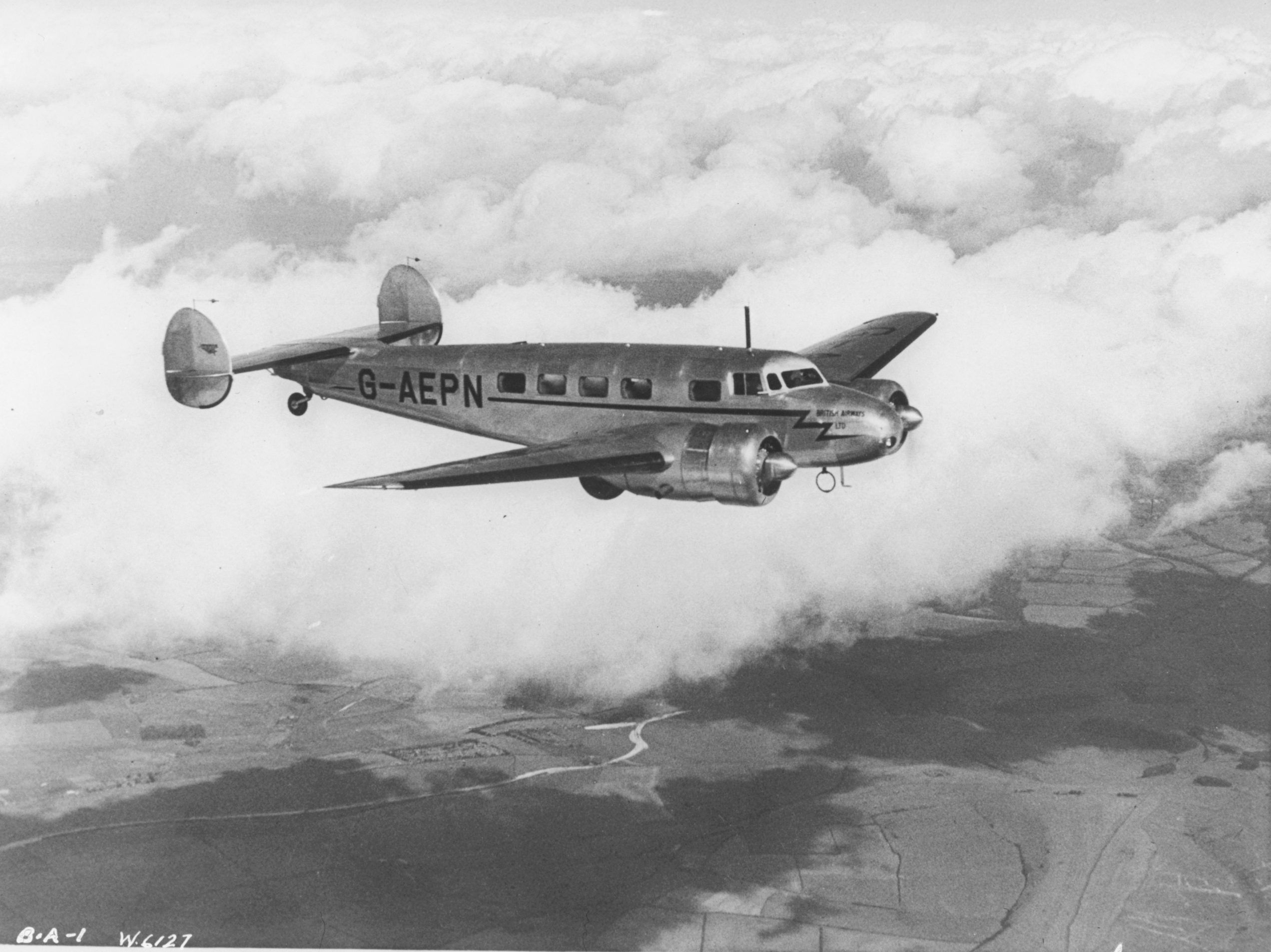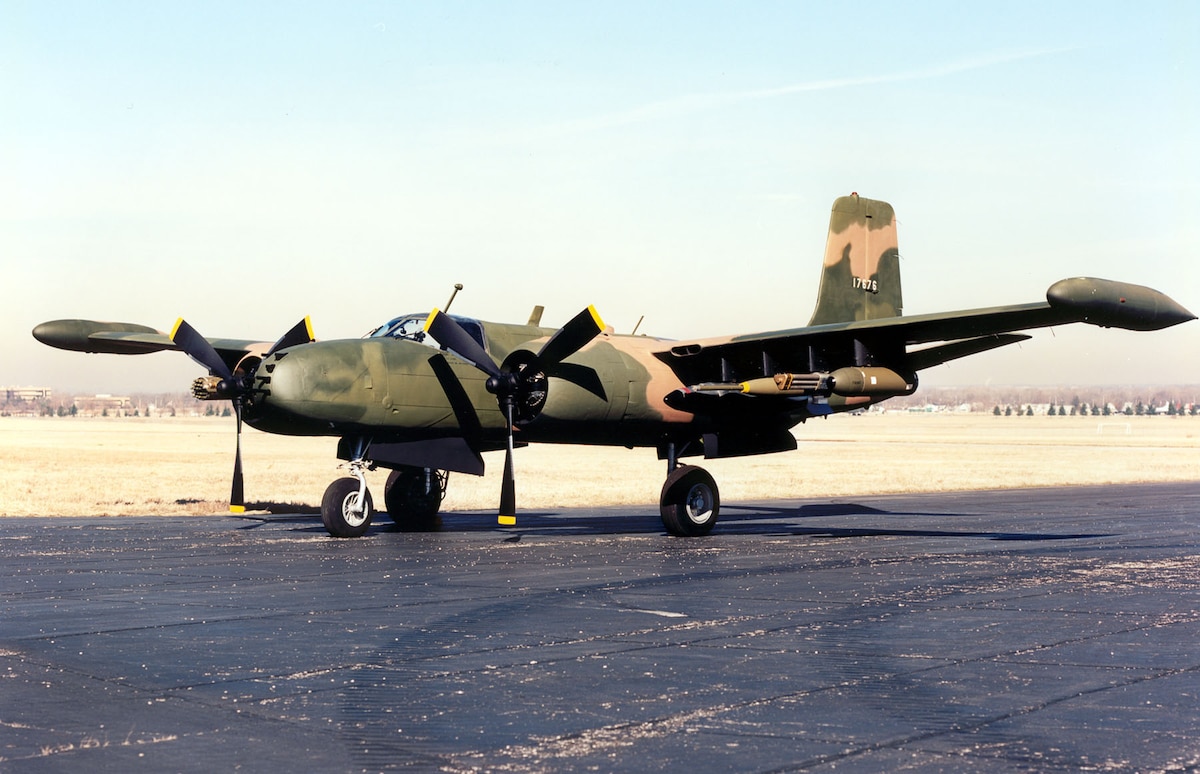Twin Tailed Aircraft - During the Normandy and Falaise campaigns, Typhoons perfected "cab rank" tactics and reported a heavy toll of German transport and armor (one thousand tanks and twelve thousand other vehicles were claimed) but sustained heavy losses. From June through August, 243 Typhoons were lost in action and 173 damaged beyond repair, the heaviest loss rate of any RAF aircraft in the campaign.
Hawker produced 3,300 Typhoons before the type was phased out in favor of the bigger, faster Tempest in 1944. Tempests played a limited role in the Normandy campaign, with an average monthly availability of fifty-fifty aircraft.
Twin Tailed Aircraft
During the Normandy campaign nearly half of all RAF fighters were Spitfires, which roamed almost at will over northern France, attacking German transport and lines of communications. Despite its potentially vulnerable liquid-cooled engine, the Spitfire was well suited as a tactical support aircraft owing to its speed, armament, and dive-bombing capability.
British Ww Aircraft Supermarine Spitfire
Some 365 Spitfires were shot down from June through August, with nearly three hundred written off—41 percent of the nearly two thousand available. New for this year in the Seminole are fuel-injected Lycoming IO-360 B1G6 engines as standard, flat rated at 180 horsepower each.
Last year's Aspen standby displays have been replaced by the Garmin G5, complementing the Seminole's Garmin G1000NXi main avionics suite. Also now standard is Garmin's GTX345 ADS-B In/Out transponder. No single aircraft has so captured the world's imagination as the Royal Air Force's sleekly elegant Spitfire.
Tracing its ancestry to a successful line of racers, the Spitfire was designed by Supermarine's chief engineer, Reginald J. Mitchell, who had produced the Schneider Trophy champions of the 1930s. First flown in March 1936, the prototype was powered by the Rolls-Royce Merlin, a liquid-cooled V-12 of one thousand horsepower.
Plane and Pilot builds on more than 50 years of serving pilots and owners of aircraft with the goal of empowering our readers to improve their knowledge and enthusiasm for aviation. Plane and Pilot expands on the vast base of knowledge and experience from aviation's most reputable influencers to inspire, educate, entertain and inform.
Design And Flight-Deck Of The Twin-Engine Turboprop Business Aircraft
There are, as you are undoubtedly aware, fewer than 10 twin-engine models in current production, some of those built in very small numbers. Piper did not sell any of its once-popular Seneca models last year, and Beech sold 15 Barons.

Worldwide, twins accounted for fewer than 100 sales, and that has been the case for almost 20 years now. Most Sunderlands in Great Britain were assigned to RAF Coastal Command general reconnaissance squadrons, conducting patrol and antisubmarine missions.
Various marks had different armament, but all included at least bow and tail turrets; a dorsal turret was also added. On rare occasions when aerial opposition was encountered, the seemingly ungainly Sunderland could protect itself against enemy twin-engine aircraft.
The uninterrupted aerodynamic curve shape from nose to tail gives reduced drag and improved laminar flow for efficient and high-performance flight characteristics. The aircraft has three separate lifting surfaces which support stability. It also has two-thirds of the conventional surface area, which also makes a major contribution to reduced drag and increased fuel efficiency.
British Ww Aircraft Avro Lancaster
That's why so much of the initial and recurrent training we do in twin-engine aircraft is with one engine caged. Twin-engine pilots need to learn how to respond to such emergencies by second nature because the time it takes to think things through when your twin loses an engine at low altitude is usually not fast enough to survive the failure.
Later in the war, more powerful Griffin engines were mated to the Spitfire airframe, resulting in even better performance. Additionally, both modified and specially built Supermarines were flown off British aircraft carriers as Seafires, bringing a degree of fighter performance previously unknown to the Royal Navy.
One of the most remarkable military aircraft of all time, the Swordfish was a biplane designed in 1933 and was still in combat in 1945. It was conceived as a carrier-based torpedo plane powered by a Pegasus radial engine of some six hundred horsepower, with
a nominal crew of three: pilot, observer, and gunner. So, the argument goes, given that singles don't have such a critical failure mode, and given that relatively few fatal accidents are caused by the loss of the single's one powerplant, one's odds might just be better in a single than in a twin

British Wwii Aircraft De Havilland Mosquito
, at least in that regard. Then again, the counterargument goes, all of the engine failures in twins that result in a safe landing somewhere never make it into the accident statistics, so the lives saved by that second engine are certainly greater than we know or have ever known.
The "Tiffy" earned a hard-won reputation as an excellent tactical support aircraft. Distinctive with its chin-mounted radiator, its rugged airframe was able to withstand considerable battle damage and still return home. The Typhoon's armament was optimized for ground attack, with four 20 mm cannon and underwing rails for eight rockets as well as two five hundred-pound bombs.
Many of today's twin-engine aircraft, however, are safer in design in a number of ways than earlier models. Counter-rotating props eliminate the problem of one of the engines being more dangerous to lose than the other.
Some new models feature full digital authority engine control (FADEC) and will automatically feather the prop (align the blades with the airflow for minimum drag on the dead engine). And all new-production twins feature more crashworthy structures than were required in the glory days, so some crashes are more survivable today.
British Ww Aircraft Short Sunderland
Twins still have their fans. Buyers of Beech Baron G58s and Diamond Aircraft DA-62s are shelling out well over a million for one of these gems, and they do so not only because they believe in the additional redundancy, performance and utility these planes offer, but also at least in
partly because multi-engine aircraft ownership still carries with it a level of status on an altogether different plane. Nearly 2,400 of the type were constructed, and one of the many ironies of the Swordfish's career is that it outlived its intended replacement, Fairey's closed-cockpit Albacore.
Even when the more advanced Barracuda monoplane arrived in fleet squadrons, the "Stringbag" soldiered on, in its own way irreplaceable. Aircraft in the light category would be examples such as the DeHavilland Dash 8 or the Twin Otter, of which are twin turboprop aircraft, operating mainly regional flights.

These aircraft will tend to operate shorter hops, and with their low weight, are able to get into smaller airfields. A great example of this is Barra airport in Scotland, where the runway is a beach!
Piaggio P Avanti Ii Twin-Engine Turboprop Business Aircraft Performance
This means that the Twin Otter, a light twin engine, is the only type of aircraft that can fly to the airport. If you're flying from a domestic airport to a small airstrip, it is very likely that you will fly in a light twin-engine aircraft.
Another great example would be the aircraft used for Safari flights. Production of Seminoles took a long holiday last year along with the rest of us, dropping from 40 in 2019 to 22 in 2020. And it should be noted that the Piper marketing team makes the point that its published pricing is straight up and “real-
world.” The Avanti II cabin is rated at 68dbA speech interference level. The pusher engines direct sound towards the tail of the aircraft, minimizing engine noise. The combined design of the wing, engine and fuselage provides a significant reduction in vibration for passenger comfort.
One unusual aspect of the Spitfire's career involved training U.S. Navy pilots to fly the British fighter. Realizing that naval gunfire spotting would be an important part of Overlord, cruiser-based aviators were qualified in Spitfires on the theory that it was easier to transition a trained spotter to fighters than to train a fighter pilot in gunfire support.
What Is The Largest Twin-Engine Plane?
Because the spotters had to fly over hostile territory, the Curtiss SOC biplanes ordinarily used would have been highly vulnerable to German flak. Aircraft in the medium category would be examples such as the a320 or Boeing 737. These aircraft have a much longer range and are able to carry many more passengers.
Airlines find these the most popular types of aircraft, both in terms of maintenance costs and operationally. Some airlines will primarily focus on one type for their fleets, for example Ryanair only operate 737's, whereas EasyJet will operate a purely Airbus fleet.
These aircraft will tend to operate short-haul or medium-haul flights. Avanti II was certified by the European Aviation Safety Agency (EASA) in October 2005 and the first aircraft was delivered to a private customer in Switzerland in December 2005, to enter service shortly after.
The aircraft received US FAA certification in March 2006. The P180 Avanti II was accredited with ANAC certification by the National Civil Aviation Authority of Brazil in November 2010. Orders were received for more than 120 Avanti II aircraft.
Our Roundup Of Light Twin Aircraft
The 50th Avanti II was delivered in October 2008. The Lancaster evolved from the Avro firm's ill-fated Manchester to become one of the great bombers of World War II. With two Rolls-Royce Vulture engines, the Manchester lacked reliability for combat operations and was abandoned after limited production.
However, to retrieve as much of the investment as possible, Avro extended Manchester's wings and put four Merlins on its airframe; pilots were delighted with the result. Beginning with airframe parts of the Beaufort, Bristol redesigned the older aircraft's fuselage to include a short, pugnacious-looking nose that gave superb forward visibility for the pilot.
The observer-navigator sat in a separate cockpit well aft, which proved fortuitous because it afforded ample room for an airborne radar. The Mark I entered Royal Navy service in 1936 and appeared little different from most carrier planes of its day—an open-cockpit biplane.
Already regarded as obsolete when the war began three years later, the ``Stringbag'' had, however, the priceless advantage of availability. It proved its worth repeatedly over the next few years, including a stunningly successful night torpedo and bombing attack on the Italian fleet in Taranto Harbor in 1940. The example set by Fleet Air Arm Swordfish so impressed the Japanese navy that the Pearl Harbor operation was based
British Ww Aircraft Westland Lysander
in part on the Taranto strike. Wartime development resulted in several models, including the Merlin powered Mark II. To enhance its strike capability, the Beaufighter received six machine guns in the wings, but its full potential was not reached until the Mark VI and later.

RAF Coastal Command relished Bristol's exceptional offensive punch, with rockets and a torpedo for antishipping strikes. The Mark X had upgraded Hercules engines of 1,770 horsepower, pushing its top speed over 300 mph. Plane and Pilot builds on more than 50 years of serving pilots and owners of aircraft with the goal of empowering our readers to improve their knowledge and enthusiasm for aviation.
Plane and Pilot expands on the vast base of knowledge and experience from aviation's most reputable influencers to inspire, educate, entertain and inform. Extremely versatile, the Handley-Page bomber doubled as a maritime patrol plane, electronic countermeasures platform, paratroop transport, and glider tug.
The latter duty was an especially important aspect of Halifax's contribution to Overlord. In June 1944 at least twenty Halifax squadrons flew from the UK with Bomber Command while others served in the Mediterranean theater. The Lysander was designed to land in confined spaces, affording liaison between army units or the army and air force.
British Ww Aircraft Handley-Page Halifax
With aerodynamically activated slats and flaps, it could be flown down to airspeeds as slow as 65 mph. Although the seemingly ungainly machine carried three machine guns and could drop small bombs, it was rarely used offensively.
It was more often employed in liaison and tactical reconnaissance missions as well as target towing and air-sea rescue. The Piaggio P180 Avanti II twin-engine turboprop business aircraft is the successor to the P180 Avanti, of which more than 100 have been produced since its entry into service in 1990. P180 Avanti II was displayed at the 2010 AirVenture held between 26 July 2010 and
29 August 2010. A commercial pilot, editor-in-chief Isabel Goyer has been flying for more than 40 years, with hundreds of different aircraft in her logbook and thousands of hours. An award-winning aviation writer, photographer and editor, Ms.
Goyer led teams at Sport Pilot, Air Progress and Flying before coming to Plane & Pilot in 2015. Beaufighters were part of the air order of battle for D-Day, particularly useful for attacking German defenses and coastal shipping.
The type was also deployed against Japan, and 364 of the total 5,928 were built under license in Australia. In March 2007, two P180 Avanti II aircraft were delivered to the Italian Guardia di Finanza border patrol agency.
Blue Panorama, an Italian airliner, ordered two P180 Avanti II aircraft in May 2009. The UAE Air Force and Air Defense acquired two P180 Avanti IIs in June 2009, as part of its expansion program. Piaggio Aero sold two P180 Avanti II aircraft to an undisclosed customer at the Singapore Airshow in 2012. The aircraft will be delivered in Beijing in July 2012. The Civil Aviation Administration of China (CAAC) certified the P180 Avanti II in October 2011.
The Pratt & Whitney Canada PT6A-66 turboprop engines are rated at 634kW. The engines drive Hartzell five-bladed, constant-speed, fully feathering, reversible-pitch, rear-facing push propellers. The position of the propellers removes the drag of propeller vortices on the wings.
twin tail airplane, twin tail jet fighter, twin tail plane, twin tail aircraft ww2, twin tail ww2 planes, plane with 2 tails, twin tail fighter plane, twin engine twin tail aircraft
